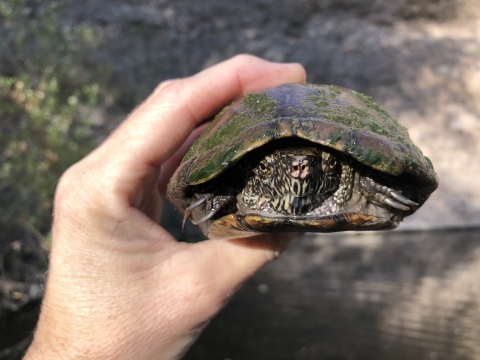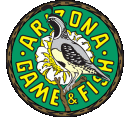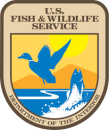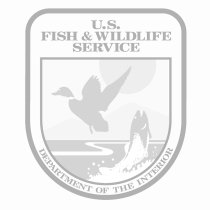Location
States
ArizonaEcosystem
River/streamIntroduction
Aravaipa and Bonita Creeks are unique aquatic systems in southern Arizona as they still support intact or nearly intact native fish assemblages. For example, Bonita Creek is home to many native fishes, including federally endangered Gila Chub (Gila intermedia), Longfin Dace (Agosia chrysogaster), Speckled Dace (Rhinichthys osculus), Desert Sucker (Pantosteus clarkii), Sonora Sucker (Catostomus insignis) and Gila Topminnow (Poeciliopsis occidentalis). Aravaipa Creek is equally diverse, with federally endangered Loach Minnow (Tiaroga cobitis) and Spikedace (Meda fulgida), Speckled and Longfin Dace, Desert and Sonora Suckers, and Roundtail Chub (Gila robusta).
Several species have invaded and established self-sustaining populations in both Aravaipa and Bonita Creeks. This includes Western Mosquitofish (Gambusia affinis), Fathead Minnow (Pimephales promelas), Yellow Bullhead (Ameiurus natalis), and Green Sunfish for Bonita Creek and the latter two non-natives and Red Shiner (Cyprinella lutrensis) in Aravaipa Creek. The Green Sunfish, which are native to eastern North America, are of particular interest and concern to managers as this species feeds aggressively on other fishes. Green sunfish were first detected in Aravaipa Creek in 1963 and have resided there for over 50 years. The native fishes in both Aravaipa and Bonita creeks have thus faced direct competition for food and habitat and have been preyed upon by established populations of Green Sunfish.
Both creeks feature downstream fish barriers constructed by the Bureau of Reclamation as part of the Gila River Basin Native Fishes Conservation Program, designed to prevent the spread of non-native aquatic species from the Colorado River via the Central Arizona Project. Aravaipa Creek is relatively unaltered by humans as it flows for 22 miles, including portions through the Aravaipa Canyon Wilderness Area, and features a fish barrier (completed in 2001) approximately five miles above its confluence at the San Pedro River. The substrate type includes sand, gravel, cobble, and boulders and a variety of mesohabitats including pools, riffles, and runs. Bonita Creek has more habitat complexity, including deeper pools, undercut banks, and surrounding vegetation. Beavers have modified the habitat at Bonita Creek, introducing woody debris into the creek, creating deep, clear backwater pools. Furthermore, a fish barrier was constructed in 2008 to prevent non-native aquatic species from moving upstream from the Gila River. The barrier, a four foot high drop structure structure
Something temporarily or permanently constructed, built, or placed; and constructed of natural or manufactured parts including, but not limited to, a building, shed, cabin, porch, bridge, walkway, stair steps, sign, landing, platform, dock, rack, fence, telecommunication device, antennae, fish cleaning table, satellite dish/mount, or well head.
Learn more about structure , is located downstream of the City of Safford’s infiltration gallery, and divides Bonita Creek into lower and upper reaches for management. After the barrier was constructed, the creek was chemically treated with rotenone (piscicide) to eradicate nonnative fishes (between the barrier and the infiltration gallery), as part of a multi-agency native fish restoration project.
Key Issues Addressed
Introduced non-native aquatic species pose a significant ecological threat to the native fish assemblages in Bonita and Aravaipa Creeks. Despite fish barriers, non-native fish species still persist in both creeks. Further, the Bonita Creek chemical treatment in 2008 failed to eliminate the non-native fish species that were present in downstream reaches. As such, additional mitigation strategies, including mechanical removal, were used by managers to remove expanding non-native fish populations. The highly piscivorous and widely abundant Green Sunfish was deemed by fish biologists as the most significant non-native aquatic species threat to native fishes in both creeks. Mechanical removal is time, effort, and financially intensive, and it is more successful in closed systems that incorporate a fish barrier to prevent recolonization of non-native species. Because of the high costs and effort needed for successful removal, adequate funding is crucial to provide for the much-needed staff and equipment resources.
Project Goals
- Conduct baseline surveys to determine native and non-native fish presence in Aravaipa and Bonita Creeks
- Protect unique native fish assemblages in Aravaipa and Bonita Creeks
- Remove non-native Green Sunfish from study locations in lower Bonita Creek, Horse Camp Canyon, a tributary to Aravaipa Creek, and mainstem Aravaipa Creek
- Conduct periodic surveys for non-native fish presence and absence
Project Highlights
Extensive Sunfish Control Efforts: During 2009-2017, over 23,000 Green Sunfish were mechanically removed by hand from Bonita Creek, and from 2010-2015 almost 4,000 Green Sunfish were removed from Horse Camp Canyon.
- Point Source Discovered: Project surveys revealed Horse Camp Canyon, a tributary to Aravaipa Creek, as the only point source for Green Sunfish. Here, sunfish have established a self-sustaining population. Horse Camp Canyon often flows intermittently, with dry sections that separate it from the mainstem Aravaipa Creek. It is only connected seasonally to Aravaipa Creek, during high flows which may enable sunfish to escape downstream.
- Total Sunfish Removed by Hand: From 2009-2017, over 23,000 sunfish were removed from Bonita Creek and from 2010-2015 close to 4,000 sunfish were removed from Horse Camp Canyon using various gear mechanisms.
- More Funding Support: Removals started in 2009 at Bonita Creek and 2010 at Horse Camp Canyon with limited available funding, which in turn limited the effort needed to adequately suppress or fully eradicate non-native sunfish. In 2016, the Bonita Creek project received additional funding from the Bureau of Reclamation (Reclamation), Gila River Basin Native Fish Conservation Program (GRBNFCP) and Bureau of Land Management (BLM) Washington Office (WO), Division of Fish and Wildlife Conservation. This added funding was pivotal for increasing capacity for removal efforts. With increased funding, project managers were able to increase sampling efforts to four days per week all year and hire additional technicians and summer interns to work on the Bonita Creek removal project.
- Working with American Conservation Experience (ACE):Access to Aravaipa Creek is arduous as it is a twelve-mile hike round trip through and along the creek, which limits the amount of gear that can be carried in and out. Extra support from an internal BLM source was used to fund an ACE youth crew for summer 2013, which was instrumental in expanding the effort into Horse Camp Canyon.
- Sunfish Eliminated in Horse Camp Canyon and Bonita Creek: Green Sunfish have not been detected in either location since 2015 and 2017, respectively. Green Sunfish have also not been captured from mainstem Aravaipa Creek since 2015.
- Native Fish Recovery: Since removing Green Sunfish, the Gila Chub population in lower Bonita Creek, in particular, is robust with multiple age classes of fish. Over 5,000 Longfin Dace were collected in Aravaipa Creek in fall 2019, the highest numbers reported in over a decade.
- Non-Native Aquatics Treatment Techniques: Project members deployed a diverse range of gear, matched to specific habitat types, to remove sunfish. Gear types included backpack electrofishers (Smith Root model LR24), Gee metal minnow traps (25 centimeter (cm) diameter, 47 cm long, double throat, 0.3 or 0.6 cm mesh), collapsible Promar® minnow nets (0.3 m diameter, 0.9 m long, double throat, 0.9 cm mesh and 0.46 m long x 0.3 m wide, with 0.6 cm mesh), hoop nets (0.66 m diameter, 1.2 m long, two-hoop, single throat, 0.6 cm mesh) seines (10 feet (ft) x 6ft, 1/8inch mesh), and dip-nets. Multiple gear types were used due to the complex habitat encountered, which included deep pools, which could not be effectively sampled with just one gear type. Backpack electrofishers were used in conjunction with dip-nets or seines (“block and shock”) in shallow pools (<3 ft deep), run, and riffle habitats. Deep pools (>3 ft deep) were sampled with Gee metal minnow traps, collapsible Promar minnow nets, and hoop nets. All traps/nets were baited with Purina Dog Chow. Promar minnow traps were also baited with wet Purina Dog Chow. All traps were set with an air pocket to prevent inadvertent drowning of non-targeted wildlife such as Sonora Mud Turtle (Kinosternon sonoriense). When possible, traps and nets were set in or next to vegetation, woody debris, or near undercut banks as Green Sunfish use these structures for cover and protection.
Lessons Learned
Follow-up monitoring by project biologists show increasing abundances of native fishes such as Gila Chub in Bonita Creek and Longfin Dace in Aravaipa Creek. Other native aquatic species have benefitted, too, with biologists observing increased populations of native lowland leopard frogs (Rana yavapaiensis) as well as macroinvertebrate diversity and abundances in Horse Camp Canyon.
Early on, project members were often told that mechanical removal was not possible in Aravaipa and Bonita Creeks due to the amount of effort needed to be effective. This project, however, demonstrates that mechanical eradication is feasible with persistence, intensive effort, and with adequate funding resources. The first few years were not successful in eliminating Green Sunfish due to a lack of financial support for intensive effort. For example, in Horse Camp Canyon, project members would start surveys in the spring by removing 600-800 Green Sunfish and end in the fall with a handful of fish remaining, only to rediscover hundreds more sunfish again the following spring. Additional funding from BLM in 2013 resulted in increased removal efforts and subsequent eradication of sunfish by 2015 in Horse Camp Canyon.
This project further demonstrates that a blanket, or one-size-fits-all approach is not always appropriate to achieve conservation and restoration goals. Project managers were successful here by being adaptable and applying context-specific approaches, while also conducting more effective, routine monitoring. The team targeted different habitat types and applied different gear types accordingly. For example, project members found traditional backpack electrofishing methods to be ineffective at capturing sunfish in the deeper, complex pools found in Bonita Creek. At times, the team set over 300 nets during sampling occasions to maximize capture probabilities. At Horse Camp Canyon, 105 larval sunfish were removed by hand using an aquarium dipnet. Experimenting with different gear types early on allowed the team to focus methods accordingly. They found that baited Promar and Gee metal minnow traps were often most effective at sampling pools in Bonita Creek, eventually removing over 20,000 sunfish using these traps alone.
Next Steps
- Ongoing monitoring is a long-term effort to ensure that Green Sunfish are no longer present in Aravaipa and Bonita Creeks.
- In recent years, Environmental DNA (eDNA) has become a useful tool for fishery scientists to detect species presence in aquatic systems. Fish and other organisms leave their fingerprint in aquatic systems through their DNA. Scientists can collect water samples and isolate DNA from the organisms that reside within to identify the species that are present. This can be particularly useful for systems like Aravaipa and Bonita Creeks, where eDNA surveys are planned to confirm the eradication of Green Sunfish.
- With the successes achieved with sunfish removal, project managers want to focus their next removal efforts on eradicating non-native Yellow Bullhead from both Aravaipa and Bonita Creeks.
- Although there is no confirmation that fish have successfully passed the barrier in Bonita Creek, Reclamation biologists and engineers have observed sunfish attempting to jump over the barrier ledge. Stream barriers can often create other indirect consequences, such as pooling upstream or downstream. If more pooling occurs downstream during higher flows and upstream from the construction of beaver dams, sunfish and other species may be capable of jumping over the barrier. As such, managers plan to modify the barrier by placing a metal grate or lip at the top of the ledge to ensure that fish passage fish passage
Fish passage is the ability of fish or other aquatic species to move freely throughout their life to find food, reproduce, and complete their natural migration cycles. Millions of barriers to fish passage across the country are fragmenting habitat and leading to species declines. The U.S. Fish and Wildlife Service's National Fish Passage Program is working to reconnect watersheds to benefit both wildlife and people.
Learn more about fish passage is prevented.
Funding Partners
- Bureau of Land Management, Washington Office Division of Fish and Wildlife Conservation
- Bureau of Reclamation Gila River Native Fishes Conservation Program
Resources
- May 19, 2020 CCAST Webinar
- Powerpoint Presentation on Green Sunfish by Heidi Blasius, BLM
- Arizona Game and Fish Department Species Page for Green Sunfish
- Overview of Physical Fish Barriers for the LCR Gila River Native Fishes Conservation Program
- Bureau of Land Management, Safford Field Office
- Bureau of Land Management, Washington Office, Division of Fish and Wildlife Conservation
- Bureau of Reclamation, Gila River Basin Native Fish Conservation Program
- The Nature Conservancy, Aravaipa Canyon Preserve
Contacts
Heidi Blasius, Fisheries Biologist, Bureau of Land Management, Safford Field Office, Interior Region 8 (Lower Colorado-Basin): hblasius@blm.gov
Case Study Lead Author
Alex Koeberle, CART Research Specialist, University of Arizona: akoeberle@email.arizona.edu
Suggested Citation
Koeberle, A.L. (2020). “Successful Green Sunfish Control in Aravaipa and Bonita Creeks.” CART. Retrieved from https://www.fws.gov/project/successful-green-sunfish-control.












